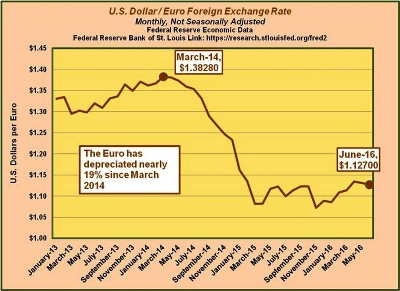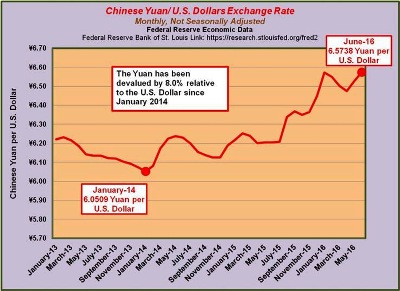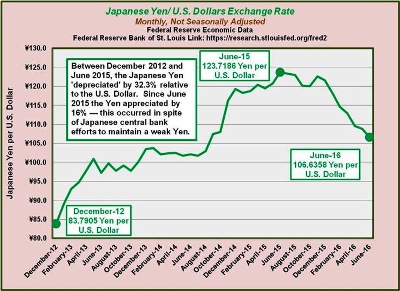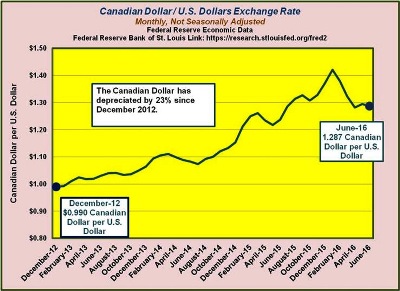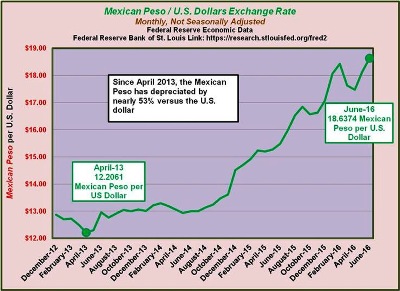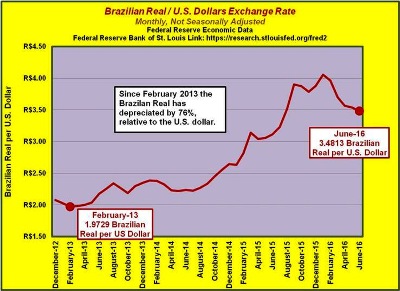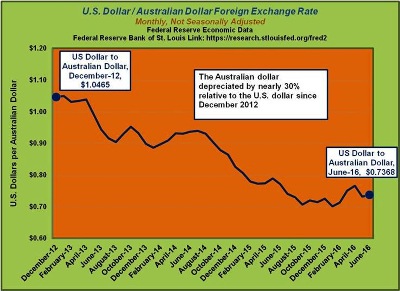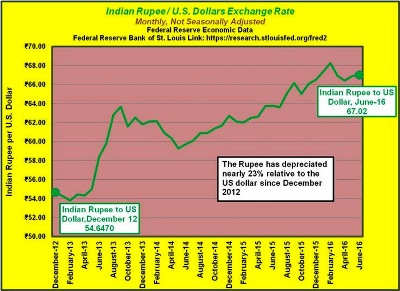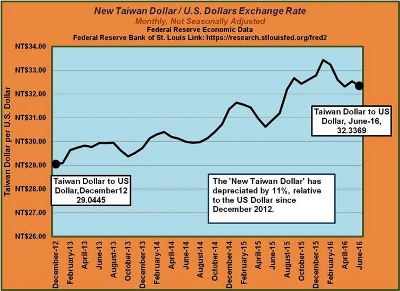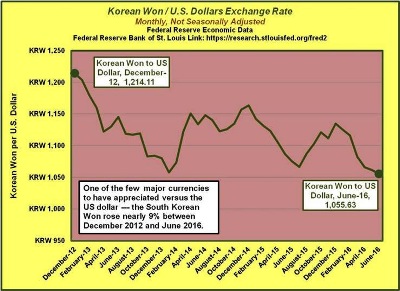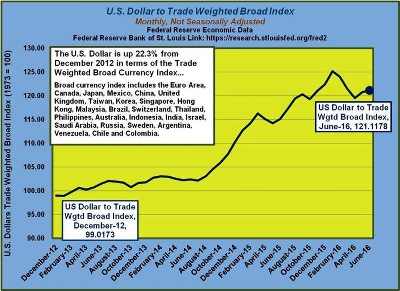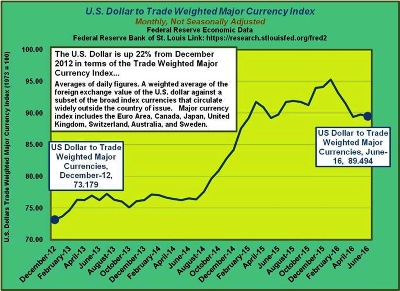2016 Volume Issue 7
Economic Newsletter for the New Millennium
June 26, 2016
For a downloadable version, click the following:
…a bit more compressed version of the PDF
A MORIBUND WORLD ECONOMY: A BALANCE OF PAYMENTS ANALYSIS OF WHO THE CULPRITS ARE; WHAT ARE THE CAUSES AND WHY IT IS SO
The finger pointing mounts, but only results in further confusion
Some analysts claim that the major cause of the slowing in the growth of the world’s economy is primarily attributable to Mainland China’s slowdown. Others argue it has to do with nations depreciating their currencies in foreign exchange markets as occurred during the "Great Depression of the 1930s. Environmentalists state it is all due to fracking. Then of course, there are the wishful thinkers that believe that that all is fine on all fronts: situation normal. Could it at least be in part due to the fact that largest economy in the world, the U.S. of A., is stagnating, or has just been limping along at a subpar rate of growth for the past several years? Perish the thought.
Mercantilism: Just another Long gone Policy; or is it Alive and Well?
Maybe it is time to integrate the lessons of history into an analysis of this global slowdown in economic growth. A good starting point would be a brief review of the rise of Mercantilism around the 16th Century as feudalism was coming to an end in many places, although some might argue its vestiges continue on in parts of the world even now.
A dominant tool of mercantilist policy was for a political entity, such as a nation seeking to expand its territorial limits, to generate a trade surplus by exporting more than it imported. If imports such as cotton were to be re-exported as cotton clothing, that trade was acceptable; but if not, imports were usually frowned upon. In the Balance of Payments Accounts (BOPA) terminology, a trade surplus is a surplus in the combined Goods and Services Account (the Goods Account was often referred to as the Merchandise Account in the past). The term surplus in this context means that the exports exceeded the imports of the nation in question. If Nation A, for example, has a surplus in its trade balance (same as its combined Goods and Services Balance) with Nation B, Nation B must for the same period of time have a deficit in that balance with Nation A.
U.S. Department of Commerce, Bureau of Economic Analysis Balance of Payments (International Transactions)
http://bea.gov/iTable.cfm?ReqID=62&step=1#reqid=62&step=2&isuri=1&6210=1
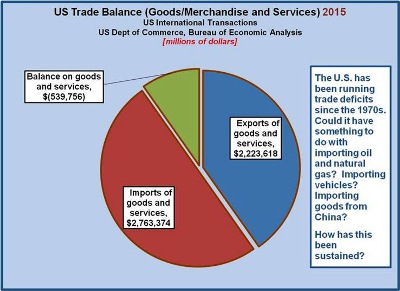
To the extent needed, we will examine the Balance of Payments Accounts and the determination of exchange rates to help lift the fog of confusion that abounds in the area of international economic and financial interrelationships between the nations of the world.
Two prices in international trade: price of the good or service; and the price of the currency
What makes analysis of the behavior of the world economy so difficult is that the international markets, with the exception of such things as swaps; two prices are involved, not just one price as in the case in purely domestic transactions. In international transactions, there is a second price beyond the price of the good or service involved; that of the price of the currency of the other nations, called the exchange rate. This is a necessity; whether to import merchandise/goods or services from other nations, give them governmental aid or private remittances, or invest long-term or short-them in those nations.
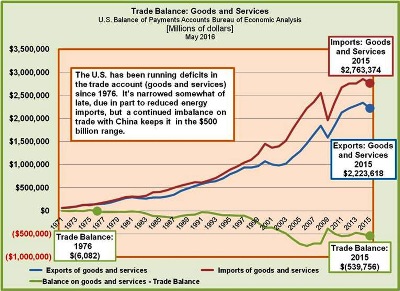
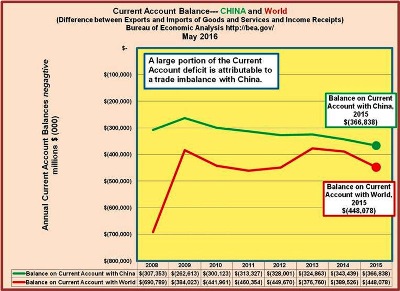
MAJOR FOREIGN HOLDERS OF TREASURY SECURITIES
U.S. Department of the Treasury
http://ticdata.treasury.gov/Publish/mfh.txt
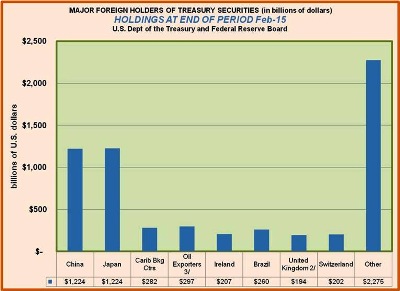

Balance of Payments
We now turn to a brief review of the balance of payments accounts (BOPA) and its usefulness as an analytical tool.
The Balance of Payments Accounts (BOPA) is a double entry bookkeeping system similar to the National Income and Product Accounts (NIPA). The BOPA measures all of these international transactions and organizes these transactions into five categories: 1) Merchandise or Goods, 2) Services, 3) Unilateral Transfers, 4) Long-term Capital; and 5) Short-term Capital transactions. It can measure not only transactions between two nations, but also between one nation and one region such as the European Union, or one nation with all other nations of the entire world.
Each of the five accounts in the Balance of Payments has a balance such as U.S. Exports of Goods (or Merchandise) minus U.S. Imports of Goods (or Merchandise) which is referred to as the Balance on Goods Account. The transactions, such as involved in the importation of goods causes a demand for foreign currency while exports of goods are a source of the supply of foreign currency. For this reason, each of the five accounts also has two sides, debits and credits in an accounting sense of these terms.
It’s important to note that each of the five accounts by themselves need not balance. They can have a surplus or a deficit balance. However, if all five accounts are combined, the sum of their balances must equal zero unless bookkeeping errors are made or transactions are incorrectly estimated. That is why the term discrepancy is found in these accounts due to the fact that many of the transactions are deliberately hidden to avoid prosecution or embarrassment to those engaged in the transactions. Money laundering is one such example of transactions difficult to estimate correctly.
The recent release of the so called Panama Papers reveals that enormous sums are involved even from officials in Communist nations such as Mainland China, no doubt for the betterment of the proletarian masses (hmmmm).
We’ll address this a bit more…
Panama Papers
https://en.wikipedia.org/wiki/Panama_Papers
A study by Andy Yan, an urban planning researcher and adjunct professor at the University of British Columbia, of real estate sales in Vancouver—also thought to be affected by foreign purchasers—found that 18% of the transactions in Vancouver's most expensive neighborhoods were cash purchases, and 66% of the owners appeared to be Chinese nationals or recent arrivals from China. Calls for more data on foreign investors have been rejected by the provincial government. Chinese nationals accounted for 70% of 2014 Vancouver home sales over $3 million Canadian.
Panama Papers - ICIJ (International Consortium of Investigative Journalists)
https://panamapapers.icij.org/
Back to the BOPA (Balance of Payments Accounts)
A deficit in an account such as the Long-Term Capital Account would contribute to a net demand for the foreign currency or currencies involved. For example if for the period of time being considered, U.S. long-term investments outside the U.S. are greater than foreign long-term investments in the U.S. it would be termed a deficit on long-term Capital Account and contribute to the depreciation of the dollar, all else equal.
Remember that when the dollar depreciates, the dollar prices of foreign currencies involved increase. If foreign long-term investment in the U.S. is greater in a time period than is U.S. long-term investment outside the U.S. it constitutes a net demand for the U.S. dollar, all else equal, and the dollar appreciates causing foreign currencies to be cheaper in dollar terms.
A surplus in a nation’s merchandise/goods account would tend to cause that nation’s currency to appreciate or experience an increase in its price in terms of the currency of the nation with the deficit in that account. Now we are able to see the relationship of a nation’s BOPA to foreign exchange markets. As the dollar appreciates, foreign goods or merchandise, services, unilateral transfers, and capital investments become cheaper in dollar terms, all else equal. As the dollar depreciates, the opposite effect occurs.
Of course, nations and their central banks can intervene directly in the foreign exchange markets as they often do, whether it’s the Bank of Japan, European Central Bank, Peoples Bank of China, etc. Selling a nation’s currency tends to depreciate it and buying its own currency with foreign currencies tends to appreciate the nation’s currency.
Chinese Spending Abroad
The Panama Papers give evidence that the flight out of a currency such as the Chinese Yuan tends to have the effect of depreciating that currency just as if its central bank had dumped its currency on foreign exchange markets. From recent reports, the end result of the Chinese currency sellers was rising prices in England with property in places like the Brighton area experiencing a 500% increase in values.
Do you live in a town where property prices are soaring? Figures for 112 cities and towns across England and Wales reveal Brighton has the biggest surge in house prices jumping 500% since 1995
www.dailymail.co.uk/news/article-3499216/House-prices-Brighton-jumped-500-1995.html
The REAL reason your children can't afford to buy their own house: How China's middle classes are snapping up British homes from Liverpool to Croydon before they're even built
In carrying out these transactions, the UK Pound tended to appreciate as the Yuan depreciated. While these transactions may raise the spirits of wishful thinkers, perhaps it does little to help raise the rate of economic growth. It is much more likely that it reflects a declining faith in the holding of assets within Mainland China or because of the potential collapse of investments within the Peoples’ Republic due to a very weak consumer demand by the proletarian masses. The true economic reality is a portrayal of real life often masked by the fairy tales of the wishful thinkers.
In the Mercantilist era, imbalances in the trade balance would be ‘settled’ by flows on money or precious metals and enhanced the ability of the nation with the surplus in its trade balance to do such things as pay mercenaries to help fight wars of territorial conquest as the British did with Hessian soldiers in e.g., in their war with their then colonies in North America. You might recall that George Washington began to turn the Revolutionary war around by defeating the Hessian mercenaries who were employed by Britain at the Battle of Trenton and was immortalized in the picture of Washington crossing the Delaware River.

Nowadays the motivation is different and this practice of developing a surplus in a nation’s trade balance becomes a way for a nation to stimulate its level of economic activity. Some apply the term Neo-Mercantilism to a nation such as Mainland China which seems to promote this tendency to experience trade balance surpluses.
Of course, the nations in such a relationship experiencing a deficit in their trade balance, such as the U.S., would experience a drag or depressing effect on their level of economic activity. This along with the uncertainty to potential employers arising from the so-called Affordable Health Care Act and presidential decrees replacing Congressional legislative actions have made capital investments by business too risky, as is seen in the underlying data for the first quarter of 2016 as just recently reported by the U.S. Bureau of Economic Analysis.
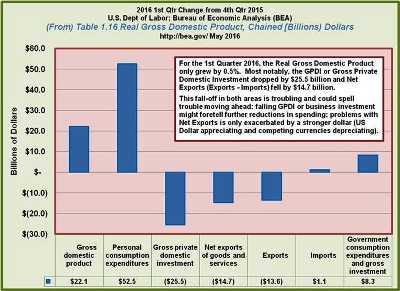
Bretton Woods Fixed Exchange Rate System
Recall that in order to rebuild Europe and Japan after WWII the Bretton Woods IMF Fixed Exchange Rate System (https://en.wikipedia.org/wiki/International_Monetary_Fund) deliberately overpriced the U.S. dollar as one way to help stimulate Europe and Japan back on the road to recovery from the devastation wrought by WWII. The success of the post-World War II recovery reflected the fact that we had learned a lesson from the failure to help bring about a recovery after the First World War. The combination of the over valuation of the dollar in the Bretton Woods IMF Fixed Exchange Rate System and the Marshall Plan were among the primary causes of the successful Post-WWII recovery.
Moving to Neo-Mercantilism
The current attempt by nations to achieve a trade balance surplus through exchange rate manipulation has no such noble justification.
While in current times the motivation is different than in the heyday of Mercantilism, the policy is the same. A surplus in its combined Merchandise/Goods and Services Accounts stimulates that nation’s level of real economic activity by increasing its aggregate demand (AD). In the parlance of the NIPA, it is termed Net Exports of Goods and Services and is one of the four components of AD. The other components of (AD) in the NIPA are Personal Consumption Expenditures, Gross Private Domestic Investment, and Government Expenditures on Goods and Services.
This is the major route or connection between international transactions and the level of domestic economic activity of the nations involved. Now you can see why some nations utilize policies to generate and enhance a surplus in their trade balance - case in point, Mainland China, which has been pursuing for many years. If China’s personal consumption and investment portions of AD are insufficient to keep the labor force employed, currency depreciation is an alternative policy. The millions displaced by the construction of the Three Gorges Dam and the 86 million ‘Population Police’ used to enforce the now abandoned One Child policy rank right up there with Khrushchev’s wasteful spending on the ‘Virgin Lands’ project of the Communist led Soviet Union (https://en.wikipedia.org/wiki/Virgin_Lands_Campaign) and do little to enable the proletariat to be able to demand consumer goods.
In effect, the policy of Mainland China is to replace a large part of its weak domestic consumer demand with that of the expropriation of some of the U.S. Personal Consumption Expenditure demand. The serious drawback of this policy for the U.S. is that in conjunction with the uncertainty of such policy as presidential edicts and the Affordable Healthcare Act, this channels a significant part of the U.S. consumer spending toward imports from the Peoples’ Republic of China away from domestic aggregate demand.
The use of a trade surplus in order to stimulate a nation’s overall level of economic activity is referred to by some as a neo-mercantilist policy nation. The difference is that a macroeconomic goal is targeted instead of a more microeconomic oriented political goal which dominated the original mercantilist period of nation building.
This has been a policy of Mainland China for many years as weak domestic consumption and at times investment, cause a shortfall fall in respect to a full employment level of GDP even with government spending added in. This form of neo-mercantilism uses the same policies but has different ends such as increases in a nation’s aggregate demand in order to increase jobs that a purely domestic aggregate demand could not achieve.
Modern day Beggaring thy Neighbor and protecting domestic jobs
Since the exchange rate can be manipulated to depreciate a nation’s currency and make its exports of goods and services cheaper to buyers in other nations, it is often resorted to as a part of a nation’s economic policy initiatives. This has been a substantial part of the so called ‘Chinese miracle’. Of course it means that nations such as the U.S. are the victim since the Mainland China trade balance surplus with the U.S. is a trade balance deficit for the U.S. with the Peoples’ Republic of China.
As pointed out earlier in this newsletter, the use of trade balance deficits that aid other nations is not new to the U.S. of A. This practice was institutionalized in the Bretton Woods Fixed Exchange Rate System (https://en.wikipedia.org/wiki/Bretton_Woods_system) that lasted from about 1945 to around 1970. The exchange rates were fixed and occasionally adjusted to deliberately value the dollar above its equilibrium level. This made the currencies of many nations including Japan and Germany priced or valued less than their equilibrium levels. Market intervention by these nations kept the dollar overvalued or overpriced and the currencies of the other nations underpriced or undervalued. In fact it was incumbent on those nations to intervene in the foreign exchange markets to make it so. While the effect was the same, the IMF Breton Woods Fixed Exchange Rate System was agreed to by a willing U.S. of A., contrary to the one-sided decision of Mainland China, as is the case now and has been the case for many years.
The more recent ‘Beggar Thy Neighbor’ policies (https://en.wikipedia.org/wiki/Beggar_thy_neighbour), such as that of the Peoples Republic of China, have been one sided decisions which deliberately depreciated currencies such as the (Chinese) Yuan. You can think of these government policies as a generalized form of dumping. Dumping is the practice of individual firms selling their products abroad at significantly lower prices than in their own domestic market. If the currencies of the nations involved become cheaper, while domestic prices of the products in those nations stay the same, the effective price to foreign importers falls and it tends to increase the exports of the nation depreciating their currencies. At the same time this decreases the imports to the nations depreciating their currencies in foreign exchange markets. This in turn increases the AD (aggregate demand) of the nation depreciating its currency. Given this fairly widespread practice of several nations in recent years, such policies of foreign governments that are major trading partners of the U.S. have been one of the contributing factors of the economic slowdown in the U.S.
Solution for redressing the trade imbalances?
If you are wondering what can be done to correct this tendency that is one of the factors currently depressing the level of economic activity and its growth rate in recent years, the answer is: plenty. Direct our central bank to sell dollars and buy foreign currency of nations that have adopted this policy of ‘beggaring their neighbors’’ instead of mending their own economy and/or political systems that have brought on these problems.
There is an old expression to which our policy makers should give more credence: "fooled once, shame on you, fooled twice, shame on me."
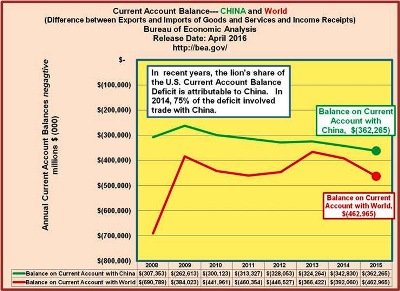
Here’s a look at the second portion of that price in international trade, the foreign exchange rate. You’ll note that most all of our trading partners have set about depreciating or devaluing their currency relative to the dollar. The only way this is really sustainable is if the domestic U.S. economy is expanding quickly enough to mitigate the negative effects of that the imports have on growth.
